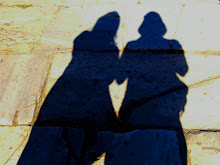 Chiang Rai, Thailand
Chiang Rai, ThailandJuly 27. 2007
N 19°54.385
E 099°49.830
We headed to the Night Bizarre for dinner last night without our rain jackets. We figured there would be a light sprinkle during our walk, but nothing we couldn’t handle. We ducked under the awnings of businesses along our way, staying pretty dry. As we neared the night market, I told Marc the plan of attack.
“Listen to the plan,” as we dodged cars to get to the entrance of the bizarre, “we walk through, check out all of the food, get a beer and decide what we want to eat.” Our plan turned out flawless, especially when the light sprinkles quickly turned into a torrential downpour. We found a little metal table under the protection of a giant tent, sat down with our beer, dry, and watched as people raced to find shelter.
 We only had to run into the rain briefly to order our curry—the best we’ve had so far in Thailand. I ventured out one other time to order another jug of Singha. The rain continued to fall and we continued to sit under the tent, simply enjoying the evening. After three liters of beer and two bowls of curry the rain finally subsided. We took the opportunity to get back to our dry room, ducking under the same awnings on our return.
We only had to run into the rain briefly to order our curry—the best we’ve had so far in Thailand. I ventured out one other time to order another jug of Singha. The rain continued to fall and we continued to sit under the tent, simply enjoying the evening. After three liters of beer and two bowls of curry the rain finally subsided. We took the opportunity to get back to our dry room, ducking under the same awnings on our return.==============================
After a good night’s sleep and a night at the bizarre our first stop this morning was to pick up our laundry. We figured there was enough sun yesterday to dry all of our items, we were happy to find everything ready for us when we arrived. This meant we could visit a few of the temples today since we now had appropriate attire.
Our first stop was the house of the emerald Buddha, or Wat Phra Kaew. We took our time meandering through the vast complex, stopping to look into a barrel containing fish with a few monks and enjoyed the house of the emerald Buddha. The large complex had so many sites within it we didn’t know which way to turn. After about an hour of wandering around we found an exit and headed down the street in search of lunch.

We strolled through a few more temples before stumbling upon a noodle shop for lunch. The tasty broth, thin slices of medium rare beef, balls of Chiang Rai sausage, bean sprouts and rice noodles was one of the best soups we had in South East Asia (with the exception of two Pho stands in Vietnam). We scooped chilies from the large bowl on the table, added black pepper mixed with chili and a few pickled peppers to form the perfect blend of spice, broth and meat. We slurped the broth, sucked noodles and savored the meat, loving every minute of it.
Who knows what kind of delicious meal tonight will bring…
Our first stop was the house of the emerald Buddha, or Wat Phra Kaew. We took our time meandering through the vast complex, stopping to look into a barrel containing fish with a few monks and enjoyed the house of the emerald Buddha. The large complex had so many sites within it we didn’t know which way to turn. After about an hour of wandering around we found an exit and headed down the street in search of lunch.

We strolled through a few more temples before stumbling upon a noodle shop for lunch. The tasty broth, thin slices of medium rare beef, balls of Chiang Rai sausage, bean sprouts and rice noodles was one of the best soups we had in South East Asia (with the exception of two Pho stands in Vietnam). We scooped chilies from the large bowl on the table, added black pepper mixed with chili and a few pickled peppers to form the perfect blend of spice, broth and meat. We slurped the broth, sucked noodles and savored the meat, loving every minute of it.
Who knows what kind of delicious meal tonight will bring…















